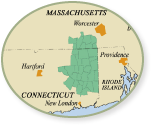
Majestic white pine green all winter
Winter is the time of the pine here in The Last Green Valley National Heritage Corridor. Pines and other conifers make up only 12 percent of the tree species in the region and for most of the year, deciduous oak, hickory, maple and birch trees dominate our summertime vistas and the autumnal foliage season. But now, as winter descends in the land, conifers demand our attention.
Pagans get credit for first bringing evergreen trees and boughs indoors to celebrate winter festivals to soften the harsh reality of the winter season. This tradition has continued through the ages to become an integral part of our Christmas celebration. To me, it is the clean pungent scent of balsam, pine and fir that signifies the joyous holiday season has arrived.
Of all the evergreen trees in our region, I am most familiar with the Eastern white pine. It is our largest pine and, perhaps, the most iconic in our region. One of my favorite books about trees is Hal Borland’s “A Countryman’s Woods” with photographs by Les Line. Here is his first paragraph about the Eastern white pine:
“The pines are far older than the broad-leafed trees. They first appeared in the Pennsylvanian Period, geologically speaking about 300 million years ago. The broad-leafed trees did not come until about 165 million years later, in the Cretaceous Period. Now the broad-leafed trees dominate, but we still have about ninety species of pine in North America, the biggest of them, the ponderosa of the West, reaching two hundred feet in height.”
Here are some facts about Eastern white pine (Pinus strobus).
– It is the largest conifer in Eastern and upper Midwest forests, reaching 150 feet in height and up to 40 inches in diameter.
– It has evergreen needles in clusters of five, soft, flexible, 2 and a half to 5 inches long, and bluish-green in appearance.
– Its cones are about 4 to 8 inches long and 1 inch thick. These remain attached for one to several months after ripening in the autumn of the second season.
– The bark is gray and smooth for younger trees and becomes rough, thick and deeply furrowed into narrow scaly ridges with age.
– Eastern white pine is a long-lived tree, reaching 200 years of age, possibly up to 450 years. A rapid grower, at 20 years, heights of 40 feet can be expected and at 40 years, 60 feet can be achieved.
– Wildlife, including gray and red squirrel, deer, mice and 16 species of songbirds, are known to eat the seed. Its boughs provide shelter for both birds and small mammals, especially during the cold winter months.
– The wood of white pine is light, durable and easy to work. It is good lumber for construction, millwork, trim, pulpwood and Christmas trees. In the Colonial era the tall straight trunks were prized for ship masts, and it’s the state tree of Maine — The Pine Tree State.
– Colonists exported white pine to Portugal, Spain and Africa, and England’s monarchy reserved the best and tallest white pines for its Royal Navy. These pines were marked with a three-strip blaze known as the King’s Broad Arrow.
– The white pine weevil is the tree’s greatest insect pest, affecting both timber quality and volume. Terminal leaders may be killed repeatedly and result in such seriously crooked stems that the tree has reduced saw timber value.
– The disease, white pine blister rust, causes losses in white pine stands.
My experience with Eastern white pine began in New Hampshire at my grandparent’s 144-acre farm, purchased in 1933. The house and barn were built between the late 1770s and early 1790s. In 1967, my father became the owner after my grandparents passed away.
With advice provided to him by the county extension service, my dad determined the more expensive maintenance needs of the old house and barn could be paid for by the sale of timber harvested from the forest surrounding the property. He hired a licensed professional forester to develop a long-range forest stewardship plan and during the past 50 years we did a half-dozen or more timber stand improvement harvests. The sale of the trees helped pay for new roofs, new septic system, electrical and plumbing upgrades and interior refurbishments of every room.
When my dad took ownership of the property the forest was comprised primarily of conifer species of Eastern white pine, hemlock and some spruce. There were also oak, maple, cherry, birch and beech, with the entire stand a diverse mix of trees of different sizes and ages.
It was the pine that had the most potential for current and future harvests. They are fast growers compared to hardwoods and our selective harvests were designed specifically to promote the growth of pine as well as the valuable hardwoods such as oak and maple.
The importance of Eastern white pine during my family’s ownership is obvious, in paying for needed repairs and refurbishments. It was also the pine trees, growing on the land when the property was first settled, that were critically important to the first inhabitants.
During the Colonial era, white pine dominated our land. These tall, readily available trees were used to build the house and barn. Thick hand-hewed timbers from long pine logs were joined with mortise and tenon and pegged together to form the outer frame of the buildings. Pine sheathing boards were nailed to the timber frame of the house and barn, and hand-planed and polished pine boards and doors comprise part of the house interior finish and trim.
After harvesting the pine trees for the buildings, the rocky land was cleared and converted to pasture for grazing livestock. Only a few hilly acres of arable land were available for oats, corn and hay, but still the first settlers persisted to make a living on the land. After the decline of agriculture in the mid- to late 1800s the land grew back its forest cover of trees.
Over the last 100 years, a diverse mix of birch, beech, maple and oak took root along with the shade-tolerant hemlock and fast-growing pine. These trees would comprise the future harvests as needed by my family.
The story and importance of white pine continues to this day on that New Hampshire forest and hillside. It started with virgin forest of white pine harvested 230 years ago to build the structures. More recently it has been 50 years of managed and harvested pine that has maintained the same buildings. Eastern white pine likes to grow on our land, and we are forever grateful it is the dominant tree in our forest.
Sources for information on Eastern white pine used for this column included The Audubon Society Field Guide to North American Trees, White Pine Fact Sheet by United States Department of Agriculture Natural Resources Conservation Service, and “A Countryman’s Woods” by Hal Borland and Les Line.
Bill Reid is chief ranger of The Last Green Valley National Heritage Corridor and has lived in the region for more than 35 years. He can be reached at bill@tlgv.org.
Get Connected
Sign up for our newsletter



